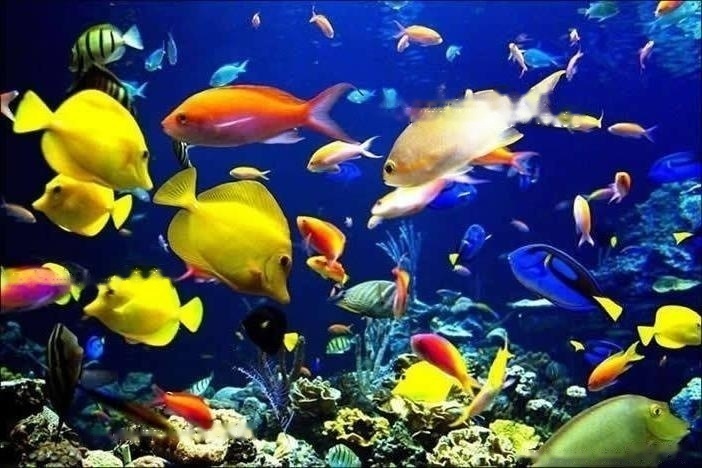
Raising fish should start with good tropical fish, and have enough experience in raising higher-level fish, and what kind of tropical fish How about a good tropical fish? Follow the editor to learn about it!
1. How to choose tropical fish
1. Carefully choose good merchants
A good aquarium shop should be clean, bright, neat and orderly, with many variety in the shop, the demonstration tank is novel and unique, the operator is knowledgeable, and it has good after-sales service.
2. Tropical fish species that are easy to raise
Guppies, swordfish, red swordfish, tricolor fish, etc. Star fish, manlong fish, kissing fish, peach core, etc., and other families such as black skirt fish, rose swordfish, zebrafish, goldfish, etc. are also easy to raise.
3. Selection of fish species
When raising tropical fish for the first time, it is best to choose tropical fish that are easy to raise, have low temperature resistance, lax water quality requirements, strong adaptability, and mixed food habits. Variety. 1-4 varieties are appropriate, and dozens or hundreds of small and medium-sized varieties are appropriate.
4. Look at the size of tropical fish
The size should be small, but too small, the fish is too tender and weak, it is unbearable for the handling process and the new water environment, especially for Fish with high water quality and dissolved oxygen requirements are more difficult to survive, so it is advisable to buy juvenile fish.
(1) Body size
For small fish with a body length of only a few centimeters, choose juveniles that are more than 2cm or about 3cm; medium-sized fish with a body length of about 10cm Juveniles of 4-5cm; juveniles of 6-9cm for large fish.
(2) large polycultures
In the same litter, choose the juveniles with large individuals, they tend to grow faster and larger, while the smaller ones tend to be larger are much inferior, and some even fall short of specifications. You can choose to raise some breeds of similar size, or choose some mild-tempered fish.
5. From the point of view of fish physique
Certain specifications represent a certain physique, but pay attention to the bright and clear body color, some species of juvenile fish body color has not yet reached the fish standard , The body is plump and strong, and the swimmer is active. Sick, wounded, mutilated, deformed and dark-colored fish are discarded.
6. Choose healthy fish
Healthy tropical fish have bright body color, smooth body surface, and fast swimming. They swim in groups and actively grab food. Healthy tropical fish are well-shaped and fast-swimming. If tropical fish are out of the group, swimming alone or hiding in a corner, they are mostly unwell.
(1) Do not select if the body color is dim.
For example, the body color of tropical fish is dim, and there is a layer of white shadows, white spots, flocculent mold, etc. on the body surface.
(2) Do not choose scales fall off
If there is congestion on the body surface or scales fall off, and white eyes or blindness are not selected, it means unhealthy.
2. Pay attention to the selection of tropical fish
1. Observation of water quality and water color
The normal water color should be clear and transparent. If the water color is turbid or colored, it indicates sparseness. The quality of the fish in this aquarium cannot be guaranteed due to the yellow, green and other colors formed by the management or the shopkeeper's medicine.
2. Observation of morphological characteristics
Although all kinds of fish have their own morphological characteristics, they have one thing in common: good quality fish should have complete scales, no damage to the body surface, and all scales can be normal. Open without damage, no abnormal spots on the body surface.
3. Guancha fish activities
Normal fish should be active and active, many species will swim in groups, and the leader is usually the top grade; Escape quickly. Irregular swimming, loneliness or no emergency response indicates poor quality fish.
4. Ask about the price and understand the diet
The price of the same fish and the same quality of fish should be moderate. If the price is too high, the owner is asking for random prices. If the price is too low, it is abnormal. . A good quality fish eats quickly, and a poor fish can indicate disease.
5. Understand the biological characteristics
Each fish has its own unique biological characteristics, which leads to different feeding methods, so it is necessary to understand the habits of the fish before feeding.
6. Preparation for transporting fish
(1) Stop feeding before transporting
It is recommended to stop feeding feed before transporting. It is necessary to stop eating for 2 days during transportation, in order to avoid a large amount of excrement discharged during transportation and pollute the water quality.
(2) Inspection of fish bags
Before use, the plastic bags for fish should be carefully checked for air leakage, and the two sides of the plastic bags containing small fish should be carefully checked. The bottom corners are tied with a string into a round shape to avoid crushing injuries. If it is some species with hard fin rays, the fish plastic bag sandwiches the newspaper to prevent the fin rays from piercing the plastic bag.
(3) Prepare suitable new water
New water, oxygen, and commonly used drugs need to be prepared for purification. If it is transported in winter, it should be prepared in a foam insulation box or a small insulation bag.
![[Dog Training 5] The training method of pet dog dining etiquette](/static/img/12192/12192_1.jpg)




